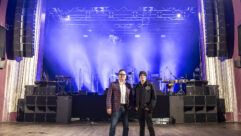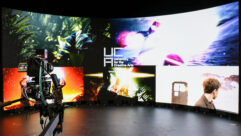

The Sweet Sounds of Green
Video systems?displays, projectors?may be obvious candidates for greening. But some audio manufacturers are trying to cut their carbon footprints.
NuVo Technologies’ Essentia EG6 is the first distributed audio system to get the U.S. government’s Energy Star seal.”>
NuVo Technologies’ Essentia EG6 is the first distributed audio system to get the U.S. government’s Energy Star seal.
ON JULY, POTOMACEDISON INCREASED electricity rates 29 percent for its Virginia customers. It’s not alone. Around the United States, many electric companies are raising their rates by 10 percent to 25 percent to compensate for the rising cost of coal and natural gas, which power their generators.
Bad news? Maybe not. Rising commercial and residential energy rates create opportunities for makers of energy-efficient AV gear. And if AV pros can tell a compelling story about the efficiency of the products they sell and install, they stand to win more business in a green-conscious world.
Although projectors and displays are obvious, visible (literally) candidates for greening (see “AV Attempts to Tread Lightly,” July 2008), a growing number of vendors are also now focusing on audio equipment, based at least in part on market demand. Not surprisingly, some say they’re seeing the most demand for energy-efficient products in regions where electrical rates are higher than average.
“There are pockets, like California,” says Richard Hanson, director of sales and marketing at Knoll Systems, based in Richmond, British Columbia. Knoll makes home theater and custom installation products (www.knoll-systems.com). “The East Coast is doing very well for us. Europe has taken this by storm.”
Amplifiers, for example, typically require a lot of electricity to drive. A significant amount of that power is lost in the form of heat—up to 80 percent by some estimates. “Audio is one of the most heat-generating components,” says David Rodarte, chief operating officer of Hebron, Ky.–based NuVo Technologies, whose products include amps, tuners, and loudspeakers (www.nuvotechnologies.com).
And there’s also a snowball effect: Depending on the installation, audio-generated heat may require air conditioning, which means additional upfront costs and even more power consumption. Therefore managing heat, among other things, can go a long way toward building energy-efficient audio gear.
But it’s not the only innovation that companies say will lead to green audio equipment.
WASTE NOT, WANT NOT
In fact, vendors are targeting a variety of design issues as they develop audio products that could be marketed as green, environmentally friendly, or sustainable—to name just a few marketing labels. Some, like NuVo, have even submitted products to the U.S. government’s Energy Star program, whose logo adorns products that meet efficiency benchmarks (www.energystar.gov).
Focusing on power supplies has proven a viable way to improve the energy efficiency of audio equipment. “Digital switching power supplies are much more efficient,” says Rodarte. “With the movement to digital amplification instead of analog, there are natural opportunities to reduce energy and radically reduce heat.”
Sunfire, which specializes in high-end home electronics and is based in Snohomish, Wash., uses an analogy to explain its Tracking Downconverter (TDC) power supply, which the company builds into receivers, amplifiers, and subwoofers for the home theater market (www.sunfire.com).
“Picture a car with [just] an on/off switch—no transmission and no accelerator,” says Eric Harper director of marketing and product development. “When it’s on, it runs 50 mph. To get it to run at 20 mph, you have to apply the brake appropriately and constantly. Typical Class A/B amplifiers work much like this: shedding excess energy to reach the desired output volume.”
Sunfire’s TDC achieves its energy savings by adding the equivalent of a gas pedal and transmission. “The power supply tracks the audio signal so we’re only producing what we need,” Harper says.
Knoll Systems, meanwhile, aims to save electricity by identifying times when power isn’t needed. “In a multichannel system, most amplifiers go into standby state that is virtually at regular idle, which is consuming quite a bit of power: 40 to 50 watts,” Hanson says. “Ours is, at most, 4 watts. So it’s a tenth of what our competitors are consuming.”
NO FAN OF HEAT
AV, heat can be bad for a variety of reasons. For example, when the goal is to reduce power usage, too much heat can mean the room needs air conditioning. If the room doesn’t already have AC, then extending the ductwork is an additional upfront expense.
But there is also the matter of heat’s effect on the audio products themselves, such as components that fail after baking in high temperatures day after day. Building fans into the product is an obvious solution, but fans present several tradeoffs, including:
- Ambient noise, which isn’t something you want to introduce more of to audio applications.
- Their own power requirements, which add to the system’s total usage.
- The possibility that their moving parts will eventually fail in the field, meaning repair costs and aggravation for the owner.
Fans also add to the vendor’s bill of materials (BoM), which affects the product’s competitive position. For example, if the product is aimed at a highly competitive part of the market, the fans could increase BoM costs to the point that it has to be priced higher than many rival products, potentially making it less attractive for users with a tight budget. BoM costs also affect the vendor’s profit margin.
Sunfire says its amps don’t produce enough heat to warrant fans. “At a recent trade show, we displayed a competitive amplifier next to our amp,” Harper says. “Using an infrared temperature sensor, we invited attendees to point it at each amp, taking note of the ambient temperature. The Sunfire TDC–based product ran almost 30 degrees cooler at idle.”
Hot-running products also can have a ripple effect on neighboring gear. “The problem with most racked gear is that the heat usually goes out of one box and into another, causing it to fail,” Harper says. “Our amps and receivers do not have top vents—only side—so there’s less ‘creepage’ into adjacent components.”
MATERIAL DIFFERENCE
Raw materials present another opportunity for audio vendors to go green and save money. Take copper, for instance. Soaring demand and frequently limited supply have pushed its price to record highs this year. By reducing the amount of copper used in their products, audio vendors can save money. On the green side, they also can note that using less copper helps reduce—even if it’s just a drop in the bucket—the amount that has to be mined, which is a process that can be environmentally unfriendly.“When you move to a digital switching power supply, you can reduce copper by 6 pounds,” says NuVo’s Rodarte.
A side benefit of digital switching can be weight reduction: If they can reduce significantly the amount of metals used, vendors also may be able to shave ounces or pounds from their products. Depending on the application, a lighter product might be a plus in the eyes of a potential customer. It could also be a huge plus for manufacturers, dealers, and installers if it translates into lower shipping costs.
Some manufactures are also focusing on the outsides of their products. Boston-based Technomad Associates, for example, recently began using recycled plastic for its loudspeaker cabinets (www.technomad.com). Technomad’s initiative is notable because the company says it did not have to introduce expensive, time-consuming changes to its manufacturing process in order to produce a greener product—something that could induce other equipment makers to explore green production.
For now, though, the vast majority of pro AV products aren’t designed and marketed with an eye toward green. For vendors targeting that niche, that’s a problem and an opportunity.
It’s a problem because success often requires extra effort in educating integrators and potential customers about the benefits of green audio. Knoll Systems, for example, is working with industry groups such as the Custom Electronic Design & Installation Association (CEDIA) to build awareness of green audio products and their benefits. NuVo, meanwhile, already sees good awareness in the custom installation market.
“That constituency has a natural understanding because they tend to do automation, which is about control, energy conservation, lighting, heating, and ventilation, so they’re already savvy to it,” Rodarte says. “Large commercial buildings are even more keen on energy conservation because of [its effect on] the bottom line.”
On the opportunity side, being in a niche market, at least for now, can be seen as an advantage because there are relatively few companies selling such products. That means less competition.
But as energy prices increase, so do the chances that green products eventually will evolve from being the exception to setting the rules. When that happens, will vendors that have pioneered green AV lose a key market differentiator? Not necessarily, especially vendors whose customers aren’t just consumers and enterprises, but also other vendors. Take Knoll, which already has a brisk business “white labeling” products such as volume controls. As demand for green products grows, some vendors are turning to Knoll so they can meet that demand.
“We’ve been approached recently by other manufacturers to build amps for them because of our technology,” Hanson says.
As consumer and enterprise interest in green AV products grows, so do dubious claims, which can make it difficult for integrators and their clients to separate those products that really do save significant amounts of energy from those that use green simply as a marketing ploy.
There’s also the possibility of a “green bubble,” where the number of products balloon, only to be followed by a sudden market shift as everyone jumps onto the next bandwagon. But some vendors believe that hype or no hype, concerns about energy efficiency are here to stay. “It will get old,” Hanson says. “There’s a life span to this stuff. But there isn’t a life span to it being an economical advantage.”
Tim Kridel is a freelance writer and analyst who covers telecom and technology based in Columbia, Mo. He can be reached at [email protected].









